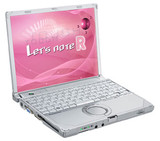Panasonic Toughbook CF-R7
Specifications

Price comparison
Average of 1 scores (from 1 reviews)
Reviews for the Panasonic Toughbook CF-R7
Source: Digital Trends
 Archive.org version
Archive.org versionThe Toughbook R7 is certainly a unique notebook in that it combines two characteristics one doesn’t normally see together – portability and ruggedness. We really like how light and portable it is, and its five-plus hours of battery life are great. This is the kind of notebook you could carry with you all day and never need to plug in. The keyboard is a bit too small for our tastes, but we suppose that sort of goes with the territory on a notebook this small. The price tag is a bit steep too, but once again these sub-notebooks are always expensive. It’s a niche product for sure, but a pretty cool one in our opinion. Plus there’s the extra geek cred of having Japanese characters on your keyboard, which is a great ice breaker on the bus or train.
8 von 10, Mobilität sehr gut, Preis schlecht
Single Review, online available, Medium, Date: 03/14/2008
Rating: Total score: 80% price: 40% mobility: 90%
Comment
Intel Graphics Media Accelerator (GMA) X3100: Intel Graphics Media Accelerator (GMA) X3100 is an integrated (onboard) graphic chip on a Mobile Intel 965GM chipset. It is the successor of GMA 950 and features a fully programmable pipeline (supports Aero Glass fully and DirectX 10 with newest drivers). The peformance of the X3100 is clearly better than the GMA 950, still demanding modern games won't run fluently.
These graphics cards are not suited for Windows 3D games. Office and Internet surfing however is possible.
» Further information can be found in our Comparison of Mobile Graphics Cards and the corresponding Benchmark List.
Intel Core 2 Duo: This is the Core Duo and Core Solo successor with a longer pipeline and 5-20% more speed without more power consumption. As an addition to the Core Duo design there exists a fourth decoder, an amplified SSE-unit and an additional arithmetical logical unit (ALU).
The Core 2 Duo for laptops is identical to the desktop Core 2 Duo processors but the notebook-processors work with lower voltages (0.95 to 1188 Volt) and a lower Frontside bus clock (1066 vs 667 MHz). The performance of equally clocked notebooks is 20-25% lower than Desktop PCs because of the lower Frontside bus clock and the slower hard disks.
U7600: » Further information can be found in our Comparison of Mobile Processsors.












